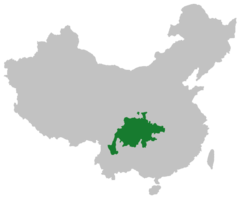Ba-Shu Chinese
Ba-Shu Chinese (Chinese: 巴蜀語; pinyin: Bāshǔ yǔ; Wade–Giles: Ba1 Shu3 Yü3; Sichuanese Pinyin: Ba¹su²yu³; IPA: [pa˥su˨˩y˥˧]), or Old Sichuanese (or Old Szechwanese; Chinese: 蜀語), is an extinct Sinitic language formerly spoken in what is now Sichuan and Chongqing, China. This language is first attested in Fangyan during the Western Han dynasty (206 BCE–8 CE) and represents one of the earliest splits from Old Chinese or Early Middle Chinese. It became extinct during the Ming dynasty, when it was supplanted by Southwestern Mandarin after settlement by people from other parts of China.
| Ba-Shu Chinese | |
|---|---|
| 巴蜀語 | |
| Native to | China |
| Region | Sichuan Basin |
| Extinct | Extinct during the Ming dynasty. Some features are preserved in Sichuanese Mandarin, especially Minjiang dialect. |
Sino-Tibetan
| |
| Language codes | |
| ISO 639-3 | None (mis) |
| Glottolog | None |
Phonological aspects of Ba-Shu Chinese are preserved in the Minjiang dialect of Sichuanese Mandarin and there is debate on whether it is a variant of Southwestern Mandarin or a modern day descendant of Ba-Shu.[1][2]
See also
References
- 向学春(2008年第5期),《四川方言中的古巴蜀土著语研究》,重庆三峡学院学报 (in Chinese)
- 刘晓南(2009年第8卷第6期),《试论宋代巴蜀方言与现代四川方言的关系——兼谈文献考证的一个重要功用: 追寻失落的方言》,语言科学 (in Chinese)
